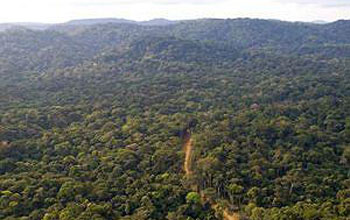
Nouabale-Ndoki National Park in Central Africa, site of the scientists' research.
Credit: Wikimedia Commons
Download the high-resolution JPG version of the image. (20 KB)
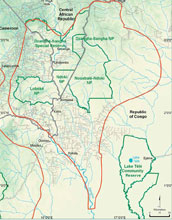
Location of Nouabale-Ndoki National Park.
Credit: Wikimedia Commons
Download the high-resolution JPG version of the image. (217 KB)
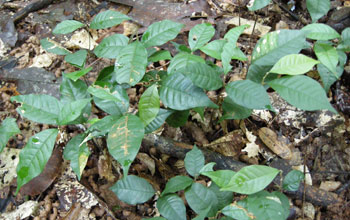
Two-year-old seedlings of a species known as African mahogany survive in the tropical forest.
Credit: Connie Clark
Download the high-resolution JPG version of the image. (2 MB)
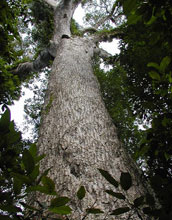
Reaching toward the sky: a canopy tree in Nouabale-Ndoki National Park.
Credit: Connie Clark
Download the high-resolution JPG version of the image. (165 KB)
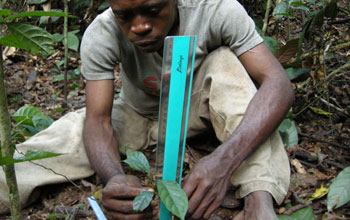
Gaston Abeya, a Mbendzele research assistant, measuring tree seedlings.
Credit: Connie Clark
Download the high-resolution JPG version of the image. (2 MB)
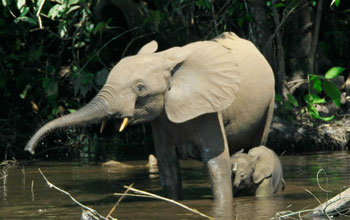
The forest elephant is one of many species that depend on tropical forests in Central Africa.
Credit: Wikimedia Commons
Download the high-resolution JPG version of the image. (3.5 MB)
Nouabale-Ndoki National Park is a tree-dotted enclave in Central
Africa's Republic of Congo. Heavy logging surrounds the park, but it
still has one of the largest intact forests in Africa. In recognition,
it recently became a UNESCO World Heritage Site.
Trees--thousands of them--make up a forest. How did Nouabale-Ndoki's trees become so numerous, and how do they stay that way?
The answer, say biologists, lies far below the tree canopy, in the soil where seedlings sprout.
Today in the journal PLOS ONE, scientists report results of an extensive seedling experiment in Nouabale-Ndoki National Park.
The research, which involved sowing 40,000 seeds of five tree species, is a new look at "seeing the forest for the trees."
The findings, which show what limits seedling growth, are important to reforestation efforts in areas that have been logged.
Every
tree can produce hundreds of thousands of seeds in its lifetime, but on
average, only one seed survives to adulthood, says John Poulsen of Duke
University, a co-author of the journal paper.
Other paper
co-authors are Connie Clark, also of Duke, and Doug Levey, formerly of
the University of Florida and now a program director in the National
Science Foundation's (NSF) Division of Environmental Biology.
Which seeds have the best chance of making it to old age?
"There
are basically two ways to look at successful seedling recruitment
[survival]," says Levey. "Species may be seed-limited or
establishment-limited."
A tree species is seed-limited if its
ability to grow is determined by whether its seeds reach a particular
location on the ground. The seeds may arrive on the wind or simply by
falling from trees.
Establishment-limited trees are those that
depend on the environment around them, rather than on seeds landing in
just the right spot. If the soil is too wet or there is too much shade,
a species is establishment-limited.
To test the importance of these two limitations on seedling recruitment, the scientists sowed tens of thousands of seeds.
They
chose the species randomly, which allowed the results to be generalized
to all tree species, not just the most common ones, says Poulsen.
The seeds were planted in different amounts in plots that stretched across an area the size of the state of Rhode Island.
Latter-day Johnny Appleseeds, the researchers couldn't do it alone, however.
"We
hired a small army of indigenous, Mbendzélé hunter-gatherers," says
Clark. "These families could easily locate seeds, and we were the
beneficiaries of their intimate knowledge of the forest's natural
history."
After the seeds were planted, the ecologists watched them grow into seedlings over two years.
They
found that only a small fraction of seeds, some 16 percent, became
seedlings. An even smaller amount, about six percent, survived to reach
their second birthdays.
When numbers of seeds were at one end of a spectrum--rare or abundant--the trees' recruitment was seed-limited.
"When
seeds were at intermediate densities," says Levey, "the chance of
recruitment was influenced by environmental factors such as soil type
and sunlight."
The importance of seed- and
establishment-limitation changes over time, Levey says. "As individual
trees get older, they need the correct soil and light exposure [become
more establishment-limited]."
Not that different from our changing needs for the right nutrients and enough light as we reach our sunset years.
| -- | Cheryl Dybas, NSF (703) 292-7734 | cdybas@nsf.gov |
The National Science Foundation (NSF)
Guillermo Gonzalo Sánchez Achutegui
ayabaca@gmail.com
ayabaca@hotmail.com
ayabaca@yahoo.com
Inscríbete en el Foro del blog y participa : A Vuelo De Un Quinde - El Foro!

No hay comentarios:
Publicar un comentario